The Ultimate Guide To Metal Countertops
On most American kitchen countertops, you’ll likely find quartz or granite — the two most popular countertop materials — but what about metal countertops? In fact, metal can be an ideal option for many homeowners as it offers amazing quality, a unique look, and numerous design options.
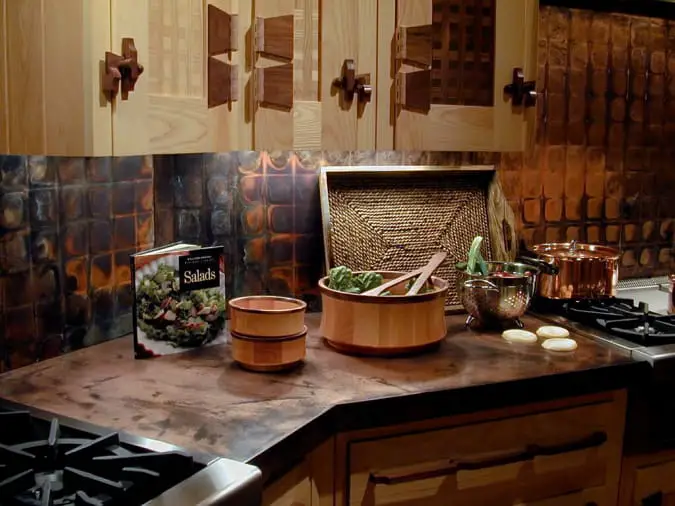 Image Source: Brooks Custom
Image Source: Brooks CustomQuick Navigation
- Types of Metal Countertops
- Cleaning and Maintaining Metal Countertops
- Style and Design Options
- How Much Do Metal Countertops Cost?
- Are Metal Countertops Better Than Other Countertop Styles?
Types of Metal Countertops
In this guide, I’ll discuss the pros & cons of the top 6 types of metal countertops including details about cost and installation so that you can select the perfect type of metal countertops for your space. Then later design options, cost, and cleaning requirements that apply to all metal countertops.
1. Stainless Steel Countertops
Typical in restaurant kitchens, stainless steel countertops provide a sterile, modern look to any space. Some homeowners specifically do not appreciate the “cold” appearance these countertops can have, but matched with purposeful décor, they can certainly provide a high-end, stylish look.
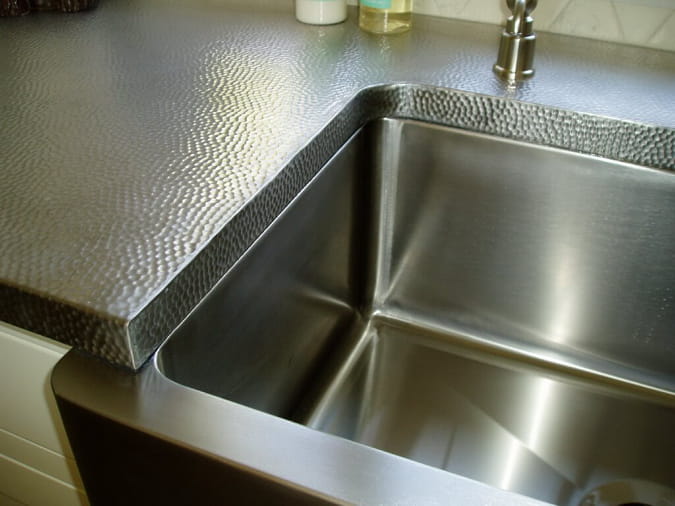 Image Source: Brooks Custom
Image Source: Brooks CustomPros
- Modern and sleek
- Rust- and burn-resistant
- Nonporous, antibacterial, and antimicrobial
- Easy to clean
- Simple installation
- Easily recyclable
Cons
- Clinical, “cold” appearance
- Can be noisy
- Susceptible to scratching and denting, which can be difficult to fix
- Susceptible to smudging and fingerprints
- Conducts heat quickly and easily if you set a hot pan on it
- Expensive
2. Copper Countertops
Copper countertops are likely the second most popular type of metal countertop. A quite old and traditional cooking material, copper has a natural beauty that harkens back to an “old world” feel. With its ability to change color (with touches of green, brown and red) and patina over time, it’s one of the most unique and versatile countertop options you’ll find.
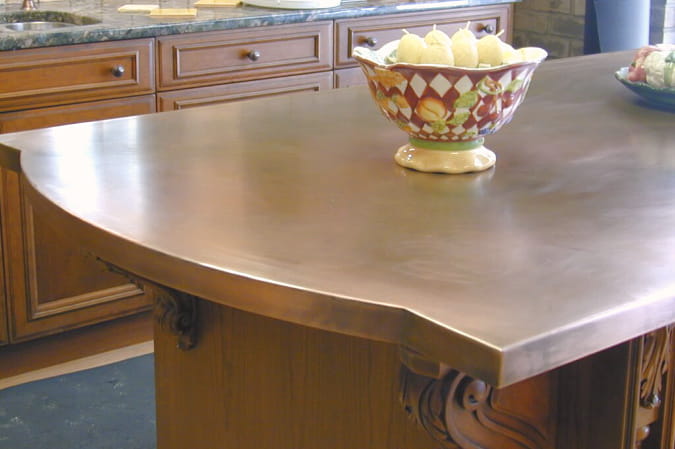 Image Source: Brooks Custom
Image Source: Brooks CustomPros
- Warm and traditional in hue and patina
- Can be kept shiny or allowed to oxidize, thus changing the patina and hue
- Easy to clean
- Often able to be salvaged from commercial environments or scrap yards and recycled again over time
- Naturally antimicrobial
Cons
- Soft, and thus easily scratched and dented
- Exact nature of change in patina over time is sometimes uncertain
- Expensive
3. Zinc Countertops
In recent years, zinc has become extremely popular as a less-clinical alternative to stainless steel. Like copper, zinc also develops a patina over time that is generally dark blue to dark bluish-gray in hue. It’s a more subdued look that goes well with a warmer, cozier style and is often seen in Parisian restaurants and patisserie shops.
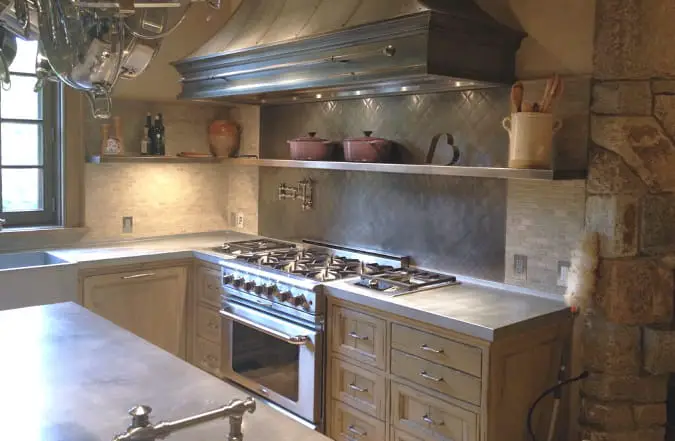 Image Source: Brooks Custom
Image Source: Brooks CustomPros
- Can be kept shiny with a finish or allowed to develop a natural grayish blue patina
- Perfect for decorative edges
- Easy cleanup
- Has antimicrobial properties
Cons
- Can warp or leave a mark when hot items are placed on it
- Soft, and thus scratches easily
- Expensive
4. Pewter Countertops
Another traditional metal that was often used to create items like plates, bowls, silverware, and basins, pewter is perfect for the homey, old world kitchen. Its true grayness has an earthy, subdued quality to it that many homeowners find perfect for the kitchen. Like zinc — which it is often confused with — pewter will develop a muted charcoal patina as it ages.
Pros
- Nonporous surface that won’t support bacteria
- Perfect for decorative edges
- Easy to clean
- Traditional and “old world” style; a typical countertop material in France for the last few centuries
Cons
- As a soft metal, it will dent and scratch easily
- Changes patina over time, and change can be unpredictable
- Expensive (more expensive than its closest counterpart, zinc)
5. Bronze Countertops
Bronze is an alloy (a combination of multiple metals) — a mixture of copper and tin. Often used on range hood sets and backsplashes, this metal can also be a high-quality countertop.
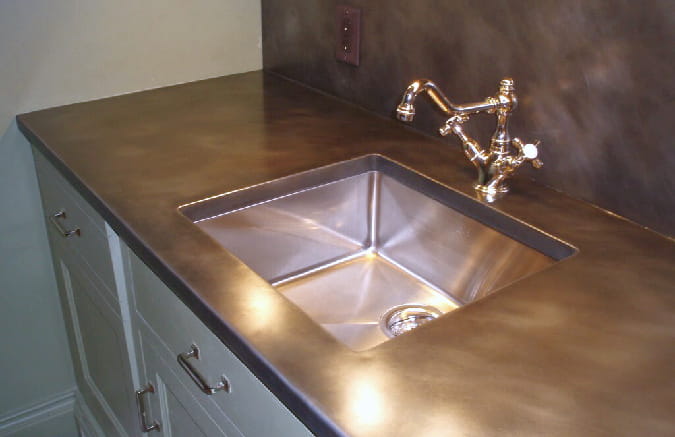 Image Source: Brooks Custom
Image Source: Brooks CustomLike copper, bronze will eventually form a patina, but overall, the surface is slow to change. If you don’t want a change or aging in the patina, of course you can also use regular chemical finishes to keep the sheen and shine.
Bronze is also a non-silver and non-gray metal that is rather darker than both copper and brass. Like brass, however, it’s quite rare to be found on countertops.
Pros
- Harder than zinc, copper, and pewter and won’t dent or scratch as readily
- Changes color and patina over time to create a brownish-blackish tone
- Unique as it’s quite rare to find on kitchen countertops
- Creates a beautiful, warm, and deep look for any kitchen
Cons
- More difficult to find
- Expensive
6. Brass Countertops
One of the rarest materials for countertops on this list, brass is also extremely unique and can give a shiny, lustrous look to any kitchen in its signature gold hue. In actuality, brass is an alloy — a mixture of copper and zinc. This mixture fortunately makes brass harder and less likely to dent.
Pros
- Much harder and won’t dent or scratch as easily as copper, pewter, and zinc
- Beautiful golden hues
- Changes color and patina over time to create a brownish-blackish tone
- Unique in that it’s not often used
Cons
- More difficult to find
- Expensive
Cleaning and Maintaining Metal Countertops
One of the best things about metal countertops is that they’re super easy to clean. Most of the time, no serious chemicals or scrubbing tools are necessary. In fact, I strongly recommend that you not use harsh and abrasive tools and products on metal as these can unnecessarily scratch and mar the surface.
Acid etching is one bugaboo, though. Acidic foods and drinks can etch metal removing the natural patina and creating spots kind of like it bleached the surface. Acids will remove the patina. So, if you’d like to go for that aged patina look, then avoid installing a metal countertop in your main food prep area.
You should especially shy away from chemical-laden cleaners. If you have a tough-to-clean spot, however, you can use a sponge with salt and warm water to lightly scrub the area.
Maintaining the finish is the main concern with metal maintenance.
If you hope to preserve the original, brand new finish of your metal countertops, you’ll need to remove the patina on a regular basis, or apply a protective coating. All metals have different rates of “aging,” so how often you do this will depend on what metal you have on your countertops.
Generally, cleaning to remove the patina will involve using some sort of acidic liquid — usually lemon juice. Of course, cleaning products are available for this specific purpose as well, but it can be done naturally if you want to avoid the use of chemicals.
One other thing to remember is that over time, you’ll notice “wear spots” on your metal. This is nothing to worry about, and many homeowners actually like it. It’s basically a worn out spot on the area of your metal countertops where you tend to do the most work — cutting, chopping, pot-setting, etc.
Style and Design Options
Even though the various metal countertop materials — stainless steel, copper, zinc, pewter, bronze, and brass — all offer their own unique style and design options, there are several overarching themes when it comes to metal countertops. And this is why I speak of them collectively in some regard.
Whether you’re just installing new kitchen countertops or revamping your entire kitchen design, you’ll want to look closely at what metal countertops can “bring to the table” so to speak.
Material Size & Thickness
A distinctive quality about metal countertops is that they aren’t installed as large slabs. That is, you aren’t getting a thick chunk of material as you would with quartz countertops, marble, or granite.
Instead, you’re getting a sheet of metal that will be bent, welded, soldered, and manipulated to fit your kitchen space.
With that said, the ultimate thickness of your countertop edges will be your choice.
The metal will be formed and fixed to wood or a higher gauge (lesser quality) stainless steel that won’t be seen. And the edges can be bent and manipulated to create your desired edge profile.
Colors
Numerous color options are available with metal countertops. Stainless steel, zinc, and pewter offer mostly gray to metallic silver options while various shades of gold, bronze, shiny salmon (similar to rose gold), brown, and metallic shades are available if you choose copper, bronze, or brass.
In addition, splashes of color may be added to certain types of metals with a specialized pre-treatment, or you might choose to let copper and several of the other metals patina and age without refinishing. This can allow for a completely new look of lustrous colors (think greens and turquoises in aged copper) or provide a more subdued, aged look — a favorite in country kitchens.
Edge Styles
Numerous edge styles are available for metal countertops. On the softer metals, like zinc and pewter, edges can be shaped into customized, decorative designs.
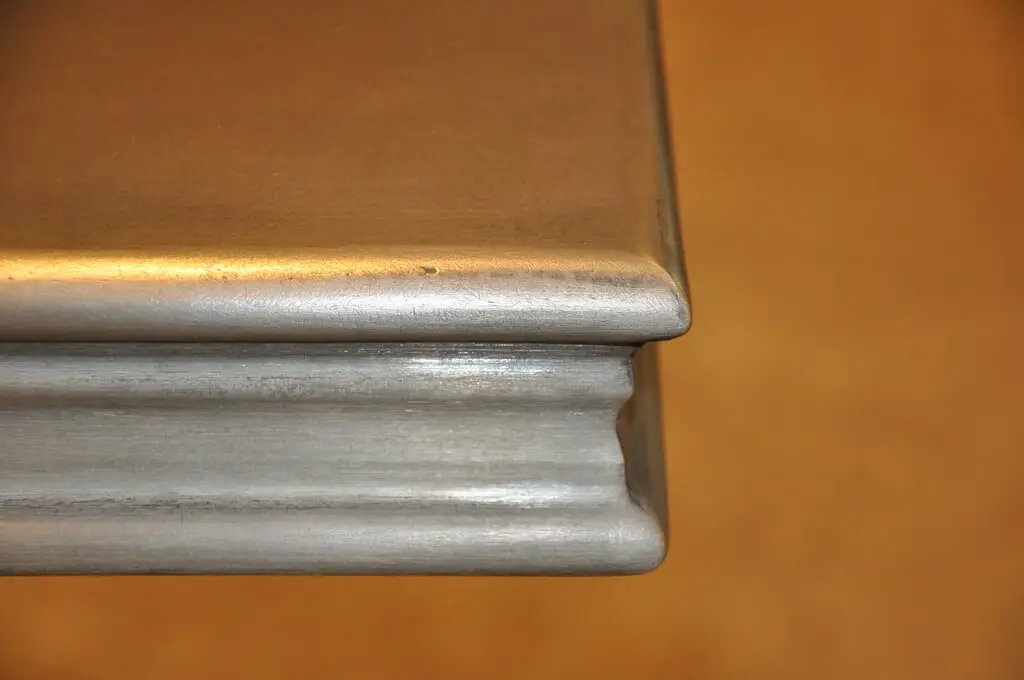 Image Source: Brooks Custom
Image Source: Brooks CustomOther metals are generally bent into traditional edge profiles, such as unwrapped, beveled, marine, or bullnose (rounded).
It must be noted here that extremely delicate edges should be avoided on the softer metals like pewter, copper, and zinc. That’s because they can easily be bent or dented out of shape. Broad designs (if designs are used) are a better choice.
Surface and Finish
Metal countertops provide a long-lasting surface that tends to be cold to the touch. In terms of finishes, most metals allow for various types, including satin polish, mirror polish, brushed, antique matte, hammered and more. Special decorative designs can even be etched into the surface of metal for a personalized touch.
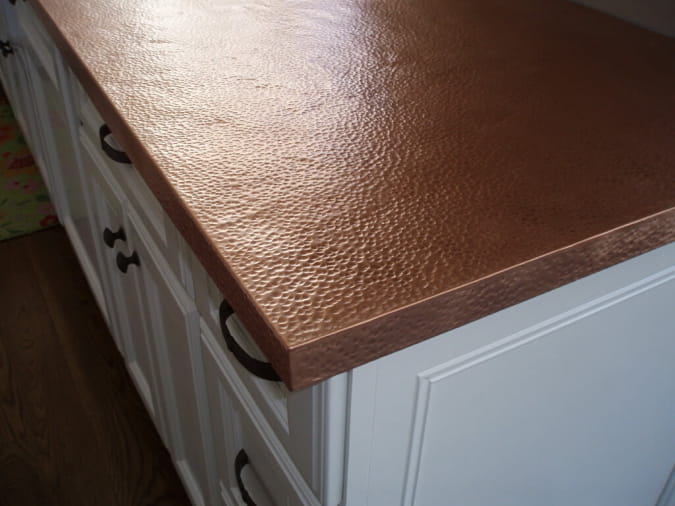 Image Source: Brooks Custom
Image Source: Brooks CustomWith most metal countertops, you may want to apply a strong wax or sealer to prevent color and patina change over time. On the other hand, some people prefer this change in color and sheen as it can provide an organic, living feel to their space. In fact, when metals like copper and pewter are used in a kitchen setting, these materials are known as “living materials” because they’re always changing.
Backsplash
As with any kitchen countertop, you'll need to consider what type of backsplash you'd like. A tile backsplash design in virtually any style can work given good color and texture coordination.
However, installing a metal backsplash using the same material as the countertop is a great choice too and creates a more cohesive look. Or possibly mix it up by choosing a tin backsplash, or stone and stainless tiles.
How Much Do Metal Countertop Cost?
Numerous factors will influence how much your metal countertops will cost. And naturally, the biggest factor will be which metal you choose. Using a cost calculator can help a lot here. Simply enter which material you plan on using, then input your installation preferences to get an instant quote.
- Expect to pay $75 - $150 per sq. ft. on average, although costs can run up to $250+ psf.
This is for “installed” metal countertops. Pre-fabricated stainless steel countertops, tables and islands are commonly available that can be purchased for much less and simply placed into your kitchen wherever desired.
Factors Influencing Cost
- Metal (and metal gauge) choice
- Finish or sealant choice
- Size of the countertop space
- Extra engineering in the material — special shapes, modifications for sinks, faucets, islands, corners, seams, backsplashes, edge profiles, and more
- Installation method
Are Metal Countertops Better Than Other Countertop Materials?
In terms of overall performance, no, metal is not better than other kitchen countertop materials. That's not to say that metal countertops are worse than all others. They simply have good and bad points like any surface.
So, it all depends on what you’re looking for and how hard you are on your countertops.
If you’re going for an uber-modern look, for example, stainless steel is arguably your best choice.
On the other hand, copper, brass, and pewter countertops are especially good at conveying an old world, “homey” feel. But of course, so are numerous other materials like wood, glass, and ceramic tile, so this is where personal preference reins.
In terms of product quality, again, there are pros and cons to various metals. Stainless steel may be resistant to burns and rust, but it’s still vulnerable to dents and nicks, and the effects are similar in most other metals.
Similarly, metals like copper and pewter are even softer than stainless steel and can actually change shape (warp) if exposed to extremely high heat. If you plan on doing a lot of cooking and like to set hot pans and pots on your countertops, these soft metals aren’t for you.
On the other hand, you always have the option of simply not using these metals near your stove and oven as well.
Furthermore, novice cooks and chefs should enjoy that nearly all metal countertops are antibacterial. This means that you can be less afraid of dangerous food bacteria growing in your kitchen and getting into what you eat. Often, this is the biggest draw for restaurant owners and chefs.
And finally, don’t forget about cost. Across the board, metal countertops tend to be more expensive than other types of countertops like granite and quartz.
Your final decision will mostly hinge on two main factors: what you plan on doing most of in your kitchen and what style and atmosphere you desire there.
Will Metal Countertops Work For You?
Metal countertops are certainly not the first choice for many homeowners. Why? Mostly because granite and quartz dominate the conversation and many homeowners simply don’t know that metal is an option! And if they do know it, they think that stainless steel is as far as it goes.
As you can see, however, there is a range of metals that can be made into gorgeous, unique countertops for your home — and they’re becoming increasingly popular, especially in urban areas where a more avant-garde look is popular.
Many of these metals are easy to install, simple to maintain, and provide a timeless look that will also make your kitchen stand out.
If you desire a truly distinctive look for your new kitchen design, metal countertops could certainly be just the thing you’ve been looking for.


